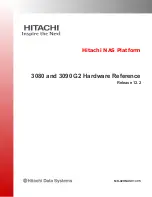
8-17
SYSTEM BUS DESIGN
The ISP has five interval timers. The counter timers are addressed as if they are contained in two
separate 8254 timers.
The ISP operates as a slave device or as a master device. In slave mode, the ISP monitors the ad-
dress lines and decodes all bus cycles. Here, an EISA master or host bus master can read or write
to any of the ISP registers. 16-bit ISA masters can read and write to any of the non-DMA registers
and to some of the non-8237/PC AT compatible registers. In the master mode, the ISP becomes
the bus master and can perform DMA or refresh cycles.
8.3.6.2
ISP-to-Host Interface
Host addresses HA31–HA2 are 3-stateable address signals which connect to the host bus. HA31–
HA20 and HA15–HA2 are bidirectional, whereas HA19–16 are outputs. In master mode all of
the address lines are outputs. In slave mode HA15–2 and HA31–2 are inputs. Upon reset these
lines are 3-stated and configured as inputs.
Byte enables (BE3#–BE0#) are 3-stateable EISA bus byte enables. In slave mode the BE2#–
BE0# are inputs and are used to access ISP internal registers. In master mode BE3#–BE0# are
outputs. BE3# is always an output.
Host write/read (HW/R#) is a bidirectional signal which indicates a read or write cycle. It is an
input during slave mode and an output during master mode. It is sent to the EBC which propa-
gates the appropriate read/write signals to the EISA bus. Upon reset this signal is 3-stated and
configured as an input.
Slow down host CPU (SLOWH#) is an output from CPU slowdown timer 2, which is used to
slow down the host CPU.
CPU cache miss (CPUMISS#) is an input signal from the host CPU, or the cache controller sub-
system which indicates that a host bus cycle is pending and must contend for the next bus arbi-
tration.
Hold acknowledge (DHLDA) is an input signal which indicates that the system has granted ISP
to the host bus.
Interrupt (INT) is an output signal which indicates that an interrupt request is pending and must
be serviced. Once asserted, it remains asserted until it receives the first INTA# pulse via the ST2#
signal. Upon reset, the state of INT is undefined.
Non-maskable interrupt (NMI) is an output used to force a non-maskable interrupt to the host
CPU. Once asserted, it remains asserted until the CPU reads to one of the NMI registers. Upon
reset this signal is low.
Parity (Parity#) is an input from the system board which indicates a main memory parity error.
8.3.7
ISP-to-EISA Interface
DMA requests (DMA 7–5, 3–0) are inputs to the ISP, which indicate requests for control of the
system bus. They are generated externally by DMA subsystems or by 16-bit masters.
DMA acknowledge (DACK 7–5, 3–0) are outputs from the ISP which indicate that the bus has
been granted to the respective requester.
Содержание Embedded Intel486
Страница 16: ......
Страница 18: ......
Страница 26: ......
Страница 28: ......
Страница 42: ......
Страница 44: ......
Страница 62: ......
Страница 64: ......
Страница 138: ......
Страница 139: ...5 Memory Subsystem Design Chapter Contents 5 1 Introduction 5 1 5 2 Processor and Cache Feature Overview 5 1 ...
Страница 140: ......
Страница 148: ......
Страница 150: ......
Страница 170: ......
Страница 172: ......
Страница 226: ......
Страница 228: ......
Страница 264: ......
Страница 282: ......
Страница 284: ......















































